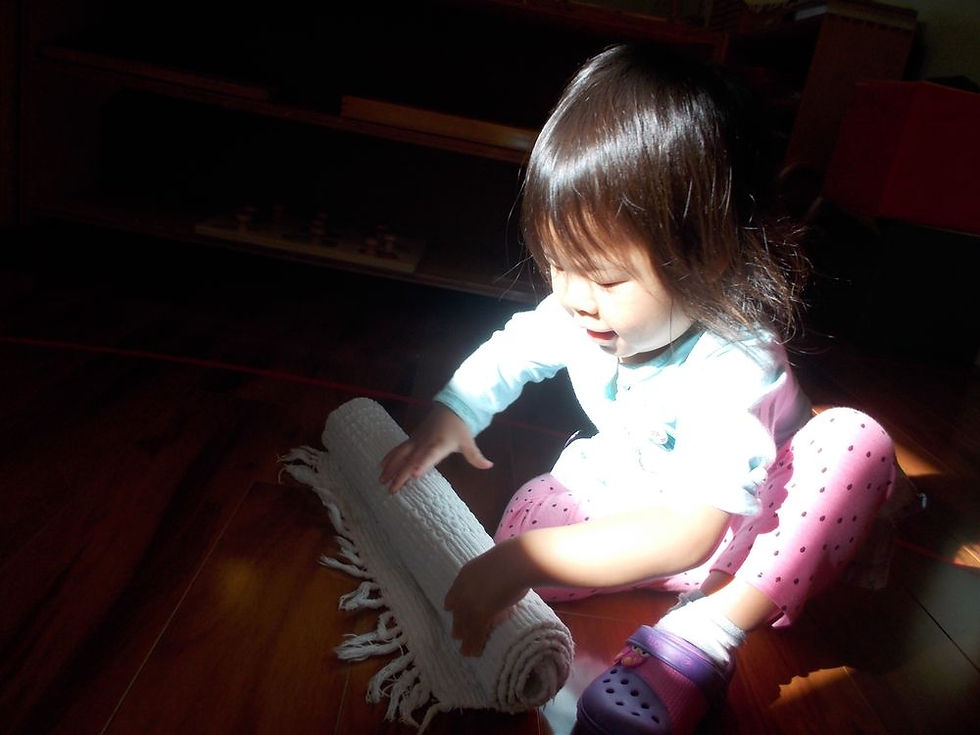


Library Square Montessori
圖書蒙特梭利雙語教室
"Help me Do It Myself!"



Practical Life
Children naturally want to adapt to their environment, so that they may become a member of the human group they belong. to.
Practical Life Exercises resemble everyday activities children observe in their daily life. These exercises allow child to perfect his/her motor skills, gain more control in the coordination of his/her movement and become an independent and confident problem solver in their community!










Sensorial
Dr. Montessori observed that children can better understand their environment through their sensory experiences. She “materialized” abstract concepts and made the sensorial materials attractive and easy for children to manipulate. For example, in Red Rods, "length" is the abstract concept isolated in this work. As the child carries the shortest red rod and eventually the longest rod, s/he develops both visual discrimination and muscle memory of length. The child’s knowledge of length, therefore, is not given through word of mouth, but through his own experiences.
Sensorial materials designed by Dr. Montessori are categorized into 8 groups: visual, tactile, baric, thermic, auditory, olfactory, gustatory and stereognosis (the ability to perceive the form of solid objects by touch). Through work with the sensorial materials, children learn to classify the things around them, and through the classification, they are also given the keys to organize their intelligence!










Music
Dr. Montessori believed that music is one of the fundamental spiritual needs of humans, therefore, at LSM, we incorporate music into the daily classroom environment as well as through music classes. Children experience and learn about music through singing and listening to different styles of music as part of their daily life.
Ear training is developed through sound exploration. The “Bells”, one of the sensorial materials, provides children experience to be familiar with the diatonic scale when they play the scale up and down. Children also learn to grade and match the pitches of bells to their corresponding bells.
The weekly music class taught by Ms. Katie emphasizes on rhythms, music literacy, learning the values of notes (such as whole, half, quarter notes, etc.), singing with hand signs (Solfege), echoing, identifying and naming the pitches, also the playing of instruments. Every week our children look forward to music class!










Language
The development of language in a child proceeds in lengthy periods of time. From ages 0 – 3, the child absorbs language unconsciously. From ages 3 to 6, the child begins a more conscious acquisition of language. It is through the experience in the environment that we support their language acquisition.
In the primary prepared classroom, the child is presented with broad exposure to language. Language is given for everything around the child! Every material that the child uses his hands to work with can be expressed in words. The child is introduced to various subject lessons such as geography, cultures, folktales from other countries, peoples, food, animals and plants, etc. Frequently, children are out in the library, on the playground, in the park, watching the community workers in action! Children learn to organize, explore and express their thoughts through daily conversations!
Since children this age have become conscious in the learning of language, they are also introduced the lessons of sounds, the symbols and the words. Once they understand that these symbols can be used to write, they will be able to express themselves in writing, they will be able to read with ease and fully grasp the thoughts of others. When this happens, they have possessed the key to the world of language, literature and communication!












Mathematics
Human baby is born of the mathematical potential. Dr. Montessori speaks of the mathematical mind of the child is built with exactitude, order and precision. It is the logical reasoning part of the mind that needs to quantify and classify in discovers. The mathematical mind gives child the ability to perceive patterns in his/her surroundings and is able to establish relationships and order of what he/she has perceived and experienced.
The Montessori math materials present the math concepts in the most tangible and intelligent way. They are exact, precise and give children sensorial impressions of the mathematical concepts. Children discover the inter-relationship between numbers and operations through the use of the math materials. Also, the sensorial experiences with the materials provide the process that leads the child to abstraction.









